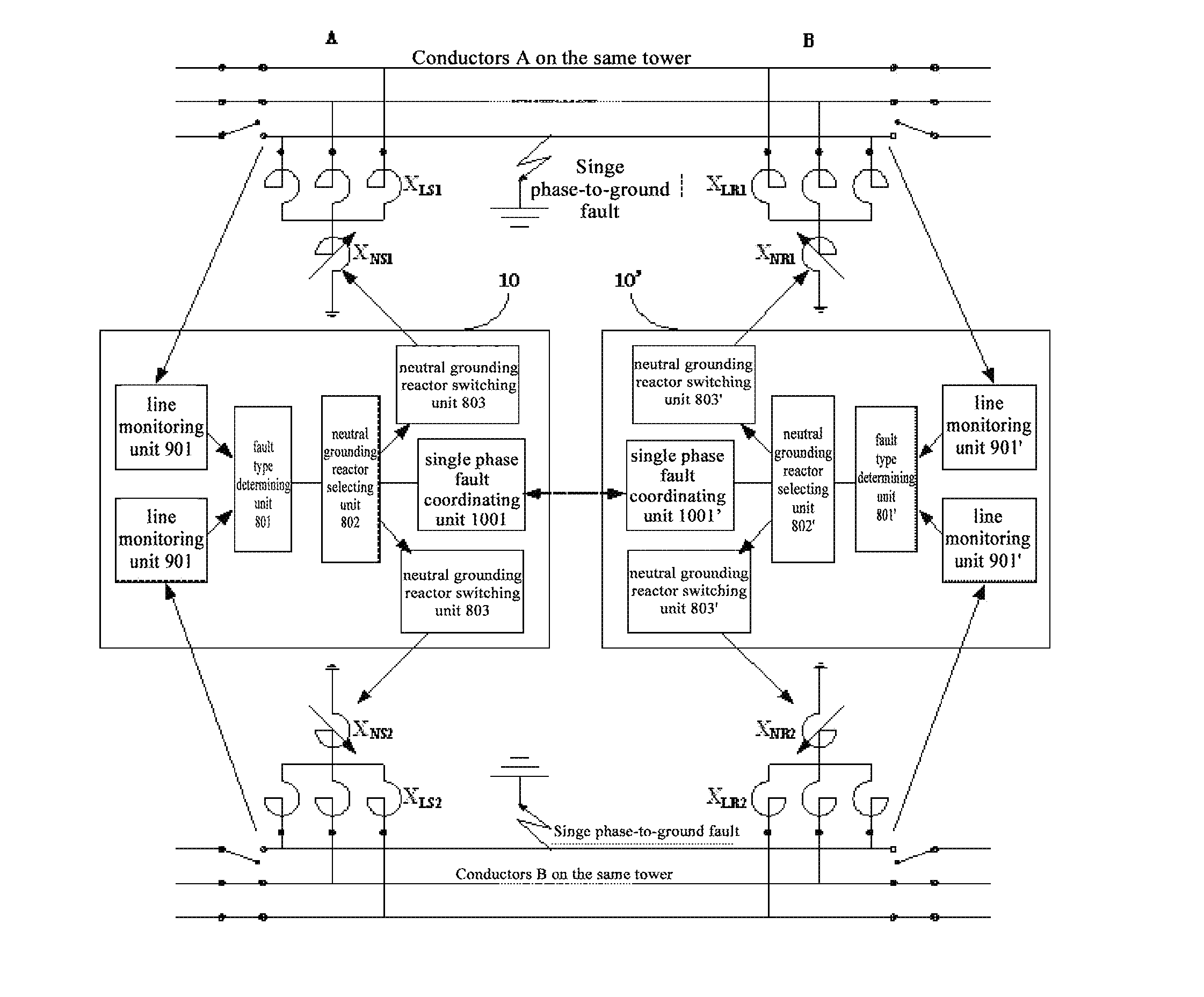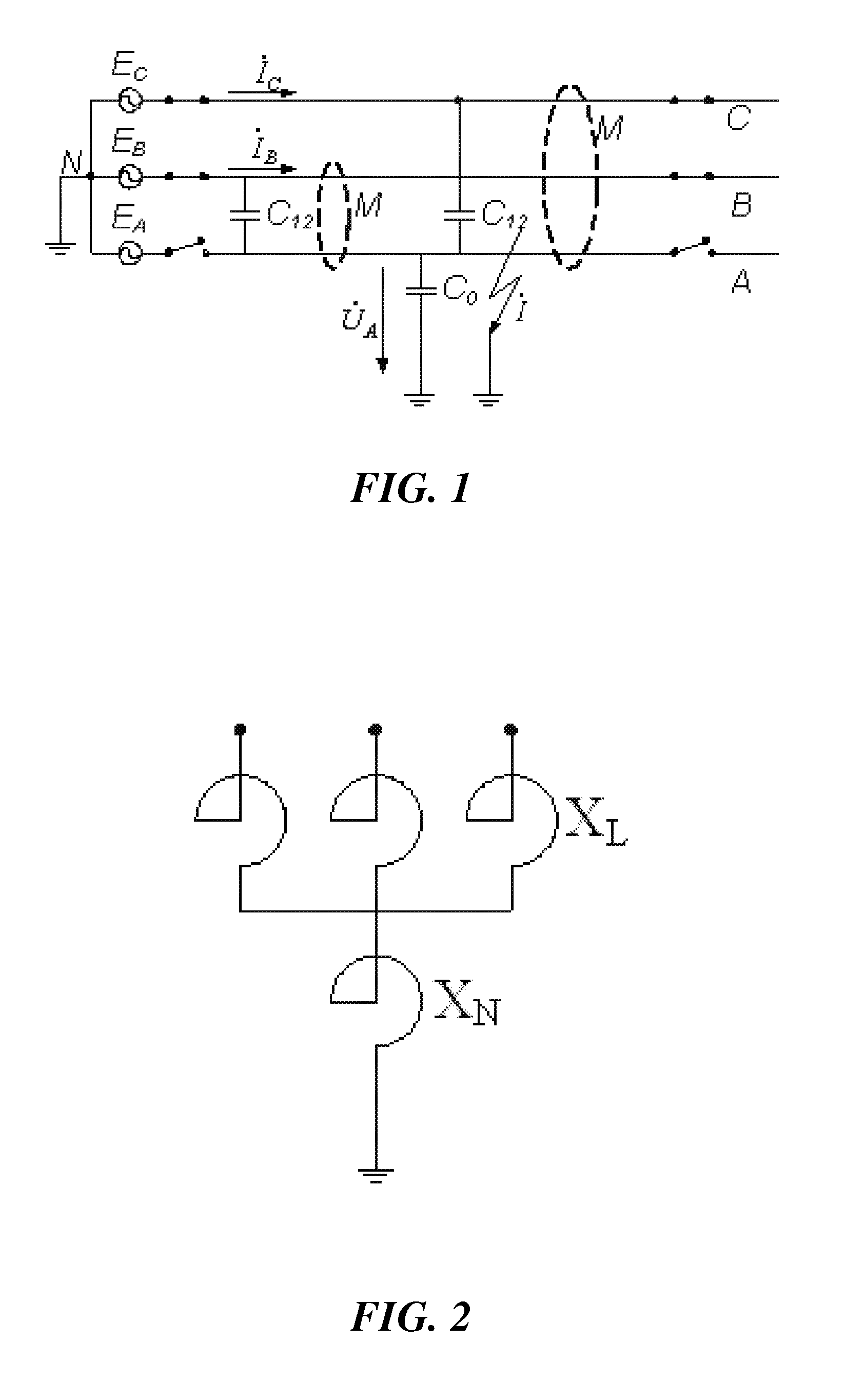Method and device for limiting secondary arc current of extra-high voltage/ultra-high voltage double circuit lines on the same tower
a double-circuit line and secondary arc current technology, applied in emergency protective arrangements for limiting excess voltage/current, short-circuit testing, instruments, etc., can solve the problems of single-phase reclosing, threatening the safety of power supply and operation stability of the transmission system, and increasing the difficulty of extinguishing secondary arc curren
- Summary
- Abstract
- Description
- Claims
- Application Information
AI Technical Summary
Benefits of technology
Problems solved by technology
Method used
Image
Examples
first embodiment
[0069]Referring to FIG. 5, FIG. 5 is a flowchart of a method according to the invention.
[0070]A method of limiting secondary arc current of an extra-high voltage / ultra-high voltage double-circuit line on the same tower according to this embodiment comprises the following steps:
[0071]S501: determining the type of a single-phase-to-ground fault when the single-phase-to-ground fault occurs on the extra-high voltage / ultra-high voltage double-circuit line on the same tower.
[0072]As an implementation, a fault phase of the extra-high voltage / ultra-high voltage double-circuit line on the same tower on which the single-phase-to-ground fault occurs is determined, and then the type of the single-phase-to-ground fault is determined according to the fault phase on which the single-phase-to-ground fault occurs and operation condition of the double-circuit line on the same tower.
[0073]For example, there are five types of fault phases on which faults may occur: single phase (double-circuit) fault, ...
second embodiment
[0089]Referring to FIG. 6, FIG. 6 is a flowchart of the method according to the invention.
[0090]S601: the sending end and receiving end of an extra-high voltage / ultra-high voltage double-circuit line on the same tower simultaneously monitor operation condition of the power transmission line.
[0091]S602: when a transformer substation at one end of the double-circuit line on the same tower firstly detects a single-phase-to-ground fault occurred on the extra-high voltage / ultra-high voltage double-circuit line on the same tower, the type of the single-phase-to-ground fault is determined;
[0092]S603: the transformer substation at one end that has firstly detected the single-phase-to-ground fault transmits the type of the single-phase-to-ground fault to the other end of the double-circuit line on the same tower through a communication channel.
[0093]S604: both ends of the double-circuit line on the same tower select reactance values of neutral grounding reactors corresponding to the type of ...
third embodiment
[0120]Referring to FIG. 10, FIG. 10 is a structural diagram of a device according to device of the invention.
[0121]In this embodiment, a device 10 and 10′ for limiting secondary arc current of an extra-high voltage / ultra-high voltage double-circuit line on the same tower are provided respectively at the sending end A and receiving end B of the extra-high voltage / ultra-high voltage double-circuit line on the same tower, for monitoring the operating condition of the power transmission line simultaneously.
[0122]The devices 10, 10′ for limiting secondary arc current of an extra-high voltage / ultra-high voltage double-circuit line on the same tower comprise single phase fault coordinating units 1001, 1001′ respectively. The single phase fault coordinating units 1001, 1001′ communicate with each other through a communication channel. When the device at one of the sending end A and receiving end B, for example, the device 10 at the sending end A has firstly detected a single-phase-to-ground...
PUM
 Login to View More
Login to View More Abstract
Description
Claims
Application Information
 Login to View More
Login to View More - R&D
- Intellectual Property
- Life Sciences
- Materials
- Tech Scout
- Unparalleled Data Quality
- Higher Quality Content
- 60% Fewer Hallucinations
Browse by: Latest US Patents, China's latest patents, Technical Efficacy Thesaurus, Application Domain, Technology Topic, Popular Technical Reports.
© 2025 PatSnap. All rights reserved.Legal|Privacy policy|Modern Slavery Act Transparency Statement|Sitemap|About US| Contact US: help@patsnap.com



